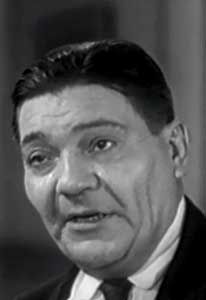Jack Teagarden Part II:
His Vocal Telescriptions
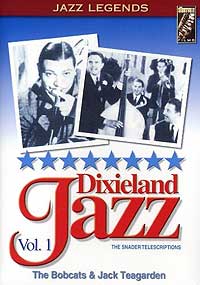 Jack Teagarden & His All Stars was a distinct band from the previous Jack Teagarden & His Orchestra. The orchestra was a Big Band, & to my ear just a bit generic for the '40s to be a real stand-out, despite the huge amount of talent the orchestra encompassed.
Jack Teagarden & His All Stars was a distinct band from the previous Jack Teagarden & His Orchestra. The orchestra was a Big Band, & to my ear just a bit generic for the '40s to be a real stand-out, despite the huge amount of talent the orchestra encompassed.
Teagarden was bankrupt by 1947 & forced to disband his orchestra, going on the road as a feature sideman with Lous Armstrong & His All Stars. He did not set out on his own again until 1951, when his own "All-Stars" were formed.
By the early '50s, the majority of the big swing bands were vanishing one after another, even as Teagarden's own band had gone. Any that lasted a little longer streamlined their bands so that smaller income from fewer bookings could be stretched further.
For a few of these streamlined groups of five, six, or ten, this was a musical improvement, because the big band arrangements had begun to sound all too similar. Bringing it back to basics with fewer musicians made the music once again personal & down to earth.
That might not have been enough to halt the rise of rock & role, & the end of swing, but if you think about which swing bands from the 30s & 40s were still recording in the 1950s, most were pretty generic-sounding unless they'd stripped down to basics.
For a new generation that did not remember what great swing bands were like, the "last" continously performing big band representing a bygone era was Guy Lombardo's orchestra seen all across America performing "Auld Lang Syne" on New Year's Eve.
The weekly representative of the music on television was Lawrence Welk (& for a shorter time Mitch Miller), not to mention Doc Severenson on Johnny Carson's Tonight show. Many will praise this stuff but frankly it had a sameness to it that did not seriously reflect the great days of Duke Ellington or Cab Calloway.
And when some radio program put together a nostalgia program piled high with Benny Goodman & the Dorseys, it would certainly sound to younger listeners as though the "best of the best" from way back then souded dangerously like elevator music that deserved the slow death it experienced in the '50s.
The exceptions were the scaled down groups. Count Basie's quintet was still doing great stuff in the '50s & a whole slug of big band performers had their last hurrahs in smaller more intimate bands.
Whether the music was transformed into a new if less commercial jazz at the hands of such as the Oscar Peterson Trio or Dizzy Gillespie/Stan Getz Sextet, or the more traditional old-timers who still had the chops, including Louis Armstrong or the new-formed Jack Teagarden & His All Stars, it was small bands that managed to evade the elevator sound that Benny Goodman-inspired music had devolved into.
And Teagarden's all-stars constituted one of the best stripped down sounds came from Jack Teagarden & His All Stars, who with changing personel would become Vegas headliners & peform until Jack's death in 1964, while so many of his contemporaries from the '30s & '40s just dropped off the map.
Jack's band had a varied sound. His long stint with Louis Armstrong was his primary influence, as was the music of New Orleans generally, but in addition to Dixieland, Teagarden's all-stars could also do a mellower swing sound. And though Jack was famed foremost for his "lead trumbone" which he turned truly into a solo instrument equal to trumpet or sax, it was Jack's great voice that made his last band such a dream.
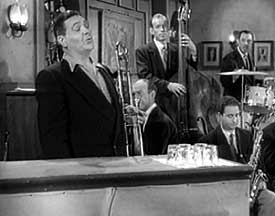 Jack's always praised in the jazz histories for his trumbone; more than any other trumbonist he made it truly a beautiful lead instrument. But his singing voice is sometimes underestimated, though it's what I like best about him.
Jack's always praised in the jazz histories for his trumbone; more than any other trumbonist he made it truly a beautiful lead instrument. But his singing voice is sometimes underestimated, though it's what I like best about him.
He'd been a featured sideman with Louis Armstrong & His All Stars in the late 1940s up to 1951, & you can hear the influence of Louis in Jack's voice, notwishtanding the fact that Jack wasn't into scatting. There's also a bit of Hoagy Carmichael in him, & strangely enough, even a little cowboy swing, just a touch, with the sound of New Orleans holding it all together.
Within weeks of forming his own All-Stars, Jack contracted to film ten Snader Telescriptions. As it was possible on a good day to film six of these, it would seem to have been two days labor undertaken in 1951, the ten films released at intervals in 1951 & 1952. These were considered "records for television," live performances played by disc jockeys in emulation of radio programs but on the new medium of tv.
The prediction that television would so closely resemble radio but with picture added turned out not to be true, & by 1952 Snader was ready to sell out its backlist to a rival company. The three-minute musical short subjects circulated to independent television stations for the next several years, syndicated by Studio Films, Inc., to be used as filler when there weren't enough ads sold to allow regular programming to end on the hour or half-hour.
The telescription Stars Fell on Alabama (1951) opens with a slow swing arrangement & Jack's trumbone. Then Jack lowers his trumbone & begins singing:
"We lived our little drama, we kissed in a field of white/ And stars fell on Alabama, last night/ I can't forget the glamor your eyes held a tender light/ While stars fell on Alabama, baby last night, wohh, last night..."
Jack does splendidly with the Frank Perkins/Mitchel Parish composition. His rough voice is simply magical.
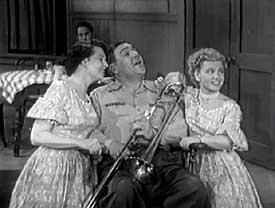 Jack takes another vocal for Rockin' Chair (1952), a song by his old pal Hoagy Carmichael. The Snaders are all filmed on the same stage tricked out to look like a small club or tavern, though there's no one serving at the bar, & there's no clientelle, just empty tables, in the club.
Jack takes another vocal for Rockin' Chair (1952), a song by his old pal Hoagy Carmichael. The Snaders are all filmed on the same stage tricked out to look like a small club or tavern, though there's no one serving at the bar, & there's no clientelle, just empty tables, in the club.
Jack has taken off his jacket & starts off the number with a slow trumbone solo. He looks tired, which is a pose, it adds a certain irony to the restful perhaps even lazy song, as this is one hard-working musician we're seeing, & he's felling like he needs a rockin' chair.
Musically this is a strong piece for Jack's trumbone as well as his voice. He performed the instrumentation on this number with Hoagy himself in the 1938 musical short they made together, titled simply Hoagy Carmichael. But it really became one of his personal standards to sing while he was part of Louis Armstrong's All-Stars in the late 40s.
When he lowers his horn & saunters over to a rocking chair, he's flanked by two young women. His gravel voice is just so winning as he begins "Old rockin' chair's got me..." & it's fantastic.
The unnamed girls sing part of the lyric with him, well enough that it's not the least spoilt, though it's Jack's voice that wins hands-down, & if you've heard Jack sing it together with Louis Armstrong, these two gals for all their talent are a poor substitute.
The younger Jack Teagarden in his big-band prime was a little dull. But when he sings, this grandfatherly-looking older Jack is just effing brilliant.
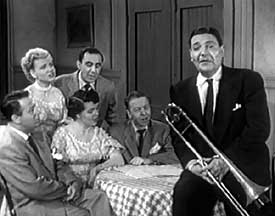 I reviewed separately Jack's instrumental telescriptions in Jack Teagarden Part I & may occasionally have sounded a little less than perfectly praising. I reviewed separately Jack's instrumental telescriptions in Jack Teagarden Part I & may occasionally have sounded a little less than perfectly praising.
That's largely because I prefer it when Jack sings, & one of my favorite of his telescriptions is Nobody Knows the Trouble I've Seen (1951), a perfect number for his mature gravelly bluesiness, & a song he'd had in his repertoire since he had his own big orchestra, having first recorded it in 1940.
As often, he begins with a blues trumbone solo. There's a harmony group at one of the tables in the bar. The bar had not had customers in the previous telescriptions. The quintet includes two women (seen also in Rockin' Chair) & three guys. They're not thrilling, in fact they're boring, & I would've kicked their asses right out of the arrangement. But Jack's so good it's certainly not spoilt by complacent harmonizers.
The nameless harmony group does one verse then there's a trumpet solo, then at long last Jack begins to sing the song right. He's sitting on the edge of the table with the harmony group, & they provide acceptable background hummings.
Jack manages to give the lyrics both sleepiness & excitement. And if I may make an oddball observation, there've been times I've seen young women dating geezers, & gotta figure the geezer is rich. But Jack at this stage of his life is geezerly in pretty sexy way, & I saw a guy like him out with a twenty-something, I'd figure she was just about as lucky as him.
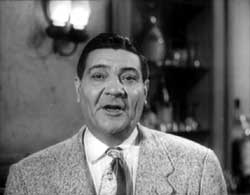 Jack Teagarden & His All Star Group perform Basin Street Blues (1951) with Jack providing an emotional lead vocal.
Jack Teagarden & His All Star Group perform Basin Street Blues (1951) with Jack providing an emotional lead vocal.
By the early 190s, Jack was pretty worn-out looking in the face, & has a gravelly voice. This song had been part of Jack's repertoir for a great long while, & few sang it better.
The song is a paeon to youth & of a vanished era, & Jack's own ceaseless touring & hard drinking had given him exactly the weathered look that made Basin Street Blues an increasingly apropos number for him. He was "aging into" the number so that he just got better & better at it.
It's impossible to overestimate his appeal as a singer, but at times, it's the appeal of a boozy old guy who'd pop up between strippers in a burlesque show. Jack was a consumate showman & knows exactly what he's doing here: this sort of image gained him great success, but it was also alarmingly honest. By his grittiness he has oodles of character.
While too many top bands were so mellow they'd put you to sleep, Jack singing Basis Street Blues is legitimately bluesy & exciting, every pour of his body conveying a legitimate right to be singing the blues:
"We'll take a boat to the land of dreams/ Steam down the river down to New Orleans." And when he sings lines like "Old friends to greet us" there's an agonizing nostalgia for vanishing days.
Jack's trumbone solo is ace, too, followed by his baby brother Charlie's trumpet solo, with some handsome drumming going on behind Charlie, courtesy of Ray Bauduck. Then it's back to Jack's vocal, including the line "Glad you came with me?" To which I say, Oh yes.
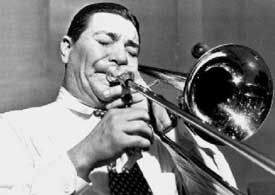 Georgia on My Mind (1952) is a number that can be done ruinously or can be done well. With Jack's voice, expect it done well.
Georgia on My Mind (1952) is a number that can be done ruinously or can be done well. With Jack's voice, expect it done well.
Beginning with Marvin Ash's piano flourish & Jack's trumbone, Charlie Teagarden's trumpet slowly insinuates itself into dominance, the arrangement is splendid.
Charlie must've wearied at least occasionally of the sobriquet "Little T," as being the younger brother of Jack meant he never got the individual attention he deserved. The consolation was that the All-Stars arrangements usually highlighted Charlie's instrument as well as Jack's.
After the instrumental opening, that handsome mature voice arrives. The only fault is the unusual brevity of this particular telescription, barely over a minute & a quarter.
All the Teagarden Snaders are gathered together on the dvd compilation misleading titles Swing Era: Benny Goodman (2004). After a couple film clips of Benny, the rest of the disc is filled out with material by Jimmy Dorsey, Hoagy Carmichael, Artie Shaw, but the runaway best turned out unexpectedly to be the set of Jack Teagarden & His All Stars telescriptions.
They are also to be found as half of The Snader Telescriptions: Dixieland Jazz Volume I: The Bobcats & Jack Teagarden (1988).
copyright © by Paghat the Ratgirl
|
